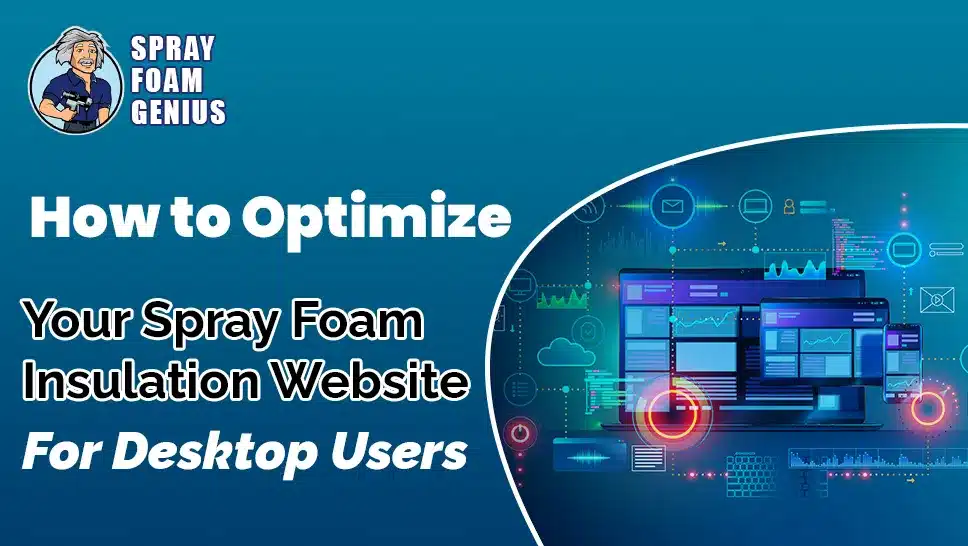
In today’s competitive digital landscape, optimizing your spray foam insulation website for desktop users is essential for standing out and capturing leads. Desktop users often engage more deeply with content and have higher conversion rates compared to mobile users. At Spray Foam Genius Marketing, we specialize in elevating the online presence of spray foam insulation contractors through expert SEO, Google Business Profile optimization, and comprehensive website development.
This detailed guide will walk you through various strategies to ensure your website performs optimally on desktop devices. From enhancing user experience to leveraging SEO techniques and improving site structure, we will cover all essential aspects to help you attract and convert more clients.
Understanding the Importance of Desktop Optimization
User Behavior and Conversion Rates
Desktop users generally exhibit different behavior compared to mobile users:
- In-Depth Research: Desktop users tend to spend more time researching and comparing services. They are more likely to explore multiple pages and review detailed content before making a decision.
- Higher Engagement: With larger screens and more precise controls, desktop users often engage more thoroughly with your site, leading to higher conversion rates.
- Professional Usage: Many decision-makers and business owners use desktops for their research, making it crucial for your site to cater to their needs effectively.
Google’s Ranking Criteria
Google’s search algorithms take desktop user experience into account. Key factors include:
- Page Load Speed: Faster-loading pages are favored by Google, impacting your search rankings.
- User Experience Metrics: Metrics like bounce rate, session duration, and page views are crucial for SEO. A well-optimized desktop site can positively influence these metrics.
Comprehensive Strategies for Desktop Optimization

1. Enhancing User Experience (UX)
A superior user experience ensures that desktop users can navigate your site effortlessly and find the information they need without frustration.
Improve Navigation
- Intuitive Menu Structure: Design a menu that categorizes your content logically. Include clear labels and organize services by type, such as residential and commercial spray foam insulation.
- Search Functionality: Implement an advanced search feature that allows users to find specific content, services, or products quickly.
Optimize Layout and Design
- Responsive Design: Even though your focus is on desktop users, a responsive design ensures your site looks and functions well across all devices. This flexibility contributes to a better overall user experience.
- Visual Hierarchy: Use headings, subheadings, and bullet points to structure your content. This approach helps users quickly scan and absorb the information they need.
Improve Page Load Speed
- Compress Images: Large image files can significantly slow down your site. Use image compression tools to reduce file sizes while maintaining quality. Tools like TinyPNG or ImageOptim can be very effective.
- Minimize HTTP Requests: Reduce the number of elements on your page, such as scripts and images, to decrease HTTP requests and enhance load times. Consider combining CSS and JavaScript files where possible.
Accessibility Considerations
- Keyboard Navigation: Ensure that all interactive elements, such as forms and buttons, are accessible via keyboard navigation.
- Alt Text for Images: Provide descriptive alt text for all images to aid users who rely on screen readers.
2. Optimizing for Search Engines (SEO)
Effective SEO practices are crucial for driving traffic to your website and improving its visibility on search engines.
Keyword Optimization
- Primary Keywords: Identify and incorporate primary keywords such as “spray foam insulation services,” “spray foam contractors,” and “insulation installation” throughout your content. Avoid keyword stuffing; instead, integrate these keywords naturally.
- Secondary Keywords: Use related terms and phrases such as “energy-efficient insulation,” “home insulation solutions,” and “commercial spray foam” to add context and depth to your content.
On-Page SEO
- Meta Tags: Optimize meta titles and descriptions with relevant keywords. This improves click-through rates from search engine results and provides a clear summary of your content.
- Header Tags: Utilize header tags (H1, H2, H3) to organize your content hierarchically. H1 tags should be used for main headings, while H2 and H3 tags can be used for subheadings and additional sections.
Content Quality
- Detailed Service Descriptions: Provide comprehensive descriptions of your spray foam insulation services. Include details about the benefits, installation processes, and any unique selling points.
- Case Studies and Testimonials: Showcase case studies and client testimonials to build credibility and demonstrate your expertise. These elements not only enhance trust but also improve your site’s authority.
Local SEO
- Google My Business Optimization: Ensure your Google Business Profile is fully optimized with accurate information, including your business name, address, phone number, and business hours. Regularly update your profile with new photos and posts.
- Local Citations: List your business in local directories and industry-specific listings to improve local search visibility. Ensure that your NAP (Name, Address, Phone Number) details are consistent across all platforms.
3. Structuring Content for Better Engagement
A well-structured content layout enhances readability and helps users quickly find the information they need.
Clear Headings and Subheadings
- Organize Content: Use descriptive headings and subheadings to break up text and make it easier for users to navigate. This also helps search engines understand the structure and relevance of your content.
- Bullet Points and Lists: Employ bullet points and numbered lists to present information in a clear, digestible format. This approach makes it easier for users to scan and absorb key points.
Engaging Multimedia
- Images and Videos: Incorporate relevant images and videos to make your content more engaging. Ensure these multimedia elements are optimized for fast loading and enhance the user experience.
- Infographics: Create and use infographics to visually represent complex data or processes. Infographics are effective for breaking down information and can be shared on social media or other platforms.
Interactive Elements
- Forms and Quizzes: Add interactive elements such as contact forms, request a quote forms, or quizzes to engage users and encourage them to interact with your site.
- Live Chat: Implement a live chat feature to provide immediate assistance to users. This can enhance user satisfaction and increase the likelihood of conversions.
4. Leveraging Internal and External Linking
Linking strategies play a crucial role in improving your website’s authority and user experience.
Internal Linking
- Relevant Pages: Link to related pages within your site to help users find additional information. For example, link from a service page to case studies or testimonials related to that service.
- Anchor Text: Use descriptive anchor text for internal links. This provides context to users and search engines about the linked content.
External Linking
- High-Authority Sources: Link to authoritative sources and industry publications to enhance your site’s credibility. This can include linking to industry standards, research reports, or influential blogs.
- Local Listings: Link to local business directories or industry associations to boost local SEO and provide users with additional resources.
5. Ensuring Mobile Optimization
Although this guide focuses on desktop optimization, ensuring mobile-friendliness is essential for overall site performance.
Responsive Design
- Fluid Layouts: Implement fluid grids and flexible images to ensure your site adapts well to various screen sizes, enhancing the user experience on both desktop and mobile devices.
- Touchscreen Interactions: Optimize interactive elements like buttons and forms for easy use on touchscreen devices. Ensure that touch targets are appropriately sized and spaced.
Mobile Page Speed
- Optimize Assets: Use techniques such as lazy loading to improve mobile page speed. Lazy loading defers the loading of images and other media until they are needed, reducing initial load times.
- Minimize Resources: Reduce the use of large files and unnecessary scripts that can slow down mobile performance. Use mobile-specific optimizations to enhance loading times.
6. Implementing Tracking and Analytics
Tracking and analyzing user behavior and site performance provide valuable insights into areas for improvement.
Set Up Google Analytics
- Track User Behavior: Monitor key metrics such as bounce rate, average session duration, and page views to understand how users interact with your site. This data helps identify areas that may need optimization.
- Analyze Conversions: Track conversion rates and the effectiveness of your call-to-action elements. Use this information to refine your strategies and improve lead generation.
Utilize Heatmaps
- User Interaction: Implement heatmaps to visualize user interactions on your site. Heatmaps show where users click, scroll, and hover, providing insights into popular areas and potential issues.
- Behavior Analysis: Analyze heatmap data to understand user behavior and make data-driven decisions for improving site layout and content.
Elevate Your Online Presence with Expert Help
Optimizing your spray foam insulation website for desktop users requires a strategic approach and ongoing efforts. At
We are dedicated to helping spray foam insulation contractors like you enhance your online presence and attract more clients. Our team of experts offers tailored solutions in SEO, website development, lead generation, and more to meet your unique needs.
Ready to optimize your spray foam insulation website for desktop users? Call us at 877-840-FOAM for USA and 844-741-FOAM for Canada visit our website at sprayfoamgeniusmarketing.com, or email us at [email protected] to get started.
Let’s take your online presence to the next level and drive more business to your door!
- Social Media Marketing for Spray Foam Businesses: What Works in 2025? - February 6, 2025
- Best SEO Strategies for Spray Foam Insulation Contractors to Rank #1 on Google - February 6, 2025
- What is Spray Foam Insulation? Benefits and Applications - February 5, 2025

